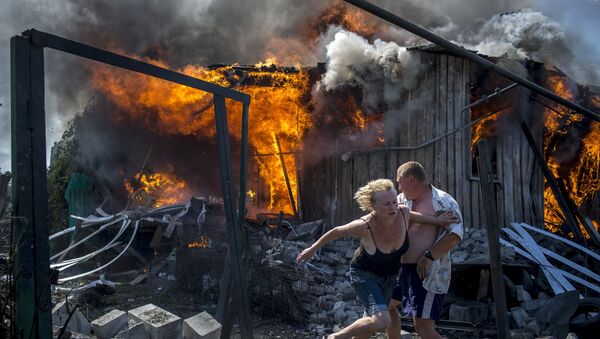The ATO was aimed at clearing some regional government buildings that had been taken over by anti-Kiev groups.
However, the operation strengthened the protesting sentiment, leading to a full-scale military confrontation and aggravating the historic divide between Ukraine’s pro-European west and the pro-Russian east.
We picked up some of the most controversial decisions by the country’s new leaders that proved to deepen the discord.
Labeling self-defense forces as terrorists
Calling the operation an “anti-terrorist” one cut off any chance for peace talks that could have calmed down the protesters, and made it seem like the operaton was the only way to resolve the crisis.
This led to violent clashes between Kiev’s forces and the self-defense groupings, especially in the regions of Donetsk and Luhansk, with both territories proclaiming independence shortly after the ATO started.
However, after months of armed standoff and thousands of deaths, Kiev’s representatives shared the negotiating table with the so-called “terrorists”, as well as Russia and the OSCE, to sign a 12-point peace plan.
The September 5th protocol, finalized in Minsk, included the implementation of a ceasefire regime that helped to alleviate the fiercest fighting, but it didn’t fully halt the violence.
Shelling civilian areas
The chaotic bombardment of cities and towns in the Donetsk and Luhansk People’s Republics made the ATO look completely ugly.
The destruction of schools, hospitals and hundreds of homes led to numerous civilian deaths and made thousands of people flee the area for their lives.
On October 20th Human Rights Watch stated that government forces violated the laws of war by using internationally banned cluster munitions in populated areas, something local reporters had been saying for months.
From the very beginning, the ATO shellings were under harsh criticism by the international community, and although Kiev eventually reduced the number of such attacks, the acts themselves were seen by many Eastern Ukrainians as a war against innocent civilians.
Enabling the Odessa massacre
Also known as the May 2nd Odessa clashes, it became one of the most horrific and tragic events Ukraine has ever witnessed.
That day, multiple street conflicts between Kiev supporters and anti-Maidan protesters forced the latter to seek refuge in the city’s Trade Unions House, which was later set on fire.
48 people were burned alive, killed or beaten to death by Euro-intergration supporters joined by radical football fans and infamous Right Sector fighters.
Despite the city police knowing about the rival gatherings, the Kiev-controlled authorities didn’t prevent the clashes and couldn’t provide timely help to the victims trapped inside the fiery building.
Arming military groups with questionable backgrounds
Aidar, Dnipro, Donbas and other battalions joined Kiev’s forces as volunteer armed units, but their murky funding and shady chain of command raised many questions about who they really serve.The most controversial one is Azov, primarily and openly staffed with far-right personnel and operated by Andrey Biletsky, an outspoken adherent of white supremacy beliefs.
The battalion’s swastika-like symbol and nationalist ideology helped Azov recruit hundreds of fighters, including women and at least one Swedish volunteer.
The very existence of an armed ultra-nationalist group under the protectorate of the Ministry of Internal Affairs cast a shadow over the new government’s military and ideological policy.
Trash bucket challenge
The brutal adaptation of the Internet-famous #IceBucketChallenge was spread across the country by radical activists beating and throwing once popular members of the old government into dumpsters.
The #TrashBucketChallenge never gained official support from the new regime, but neither was it stopped by police who were sometimes present at the crime scenes, nor ever investigated.
Such neglect contributed to running the image of the opposition into the ground before the October 26th parliamentary elections.




